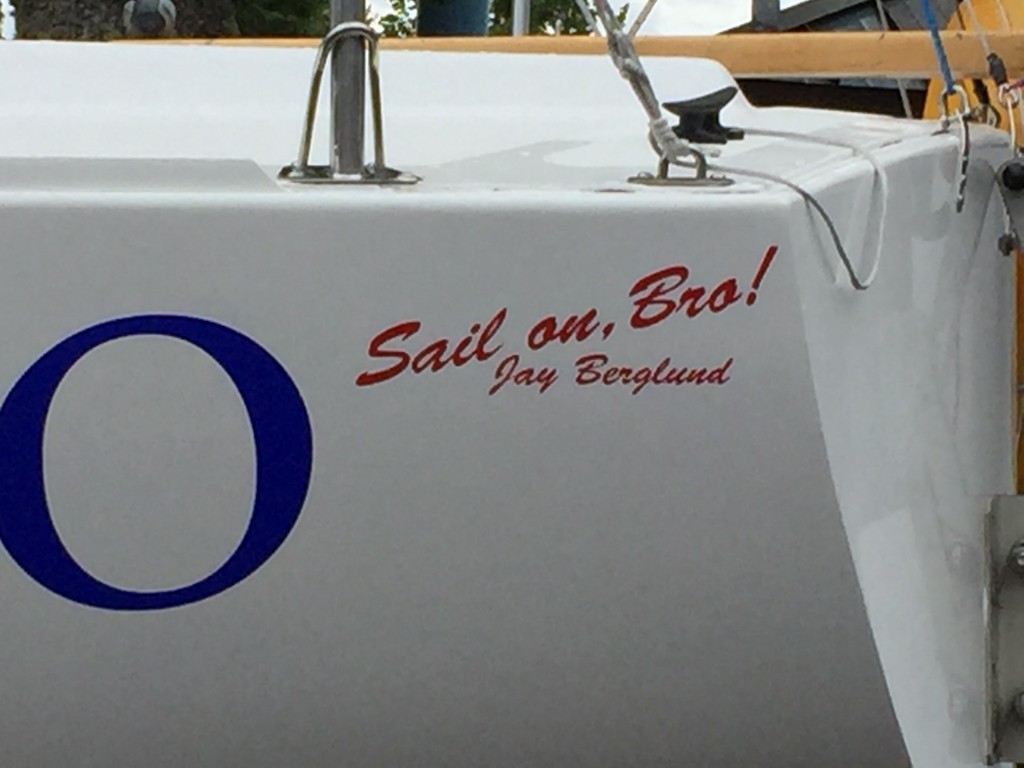 A little over a year ago, tragedy struck the sailboat racing community when Jay Berglund died after the 22′ Gizmo sank in Budd Inlet. Gizmo‘s owner John Thompson shares the story of the boat’s resurrection, return to the race course and a bold plan to race her in the R2AK. Jay Berglund’s spirit is aboard every step of the way.
A little over a year ago, tragedy struck the sailboat racing community when Jay Berglund died after the 22′ Gizmo sank in Budd Inlet. Gizmo‘s owner John Thompson shares the story of the boat’s resurrection, return to the race course and a bold plan to race her in the R2AK. Jay Berglund’s spirit is aboard every step of the way.
The team website is www.TeamGhostRider.com. Check out out for details on the R2AK effort and opportunities to help the team put together the effort Berglund would be proud of. All stories by John Thompson.
Team Ghost Rider
Jay Berglund passed away on October 25, 2014, but his spirit will accompany the crew of Gizmo as they race northwards towards Ketchikan in the 2016 Race to Alaska. It might be an unfair advantage, but the crew is counting on Jay to interfere with the competitor’s wind, while providing fair wind and following seas to little Gizmo, a 1979 Harmony 22 sailboat. While Jay may have passed away at the young age of 46 on that October day, his death actually started a few years prior when he was diagnosed with a rare degenerative neurological disease. He was slowly fading away to a slow, bed-ridden death.
Click on any picture to enlarge and see slide show.
In his healthy years, Jay was an avid hunter, fisherman and a professional sailor. He was well known within the fishing circles for being able to catch his limit of salmon within a very short time while other fishermen in the same stretch of river were catching absolutely nothing. He was a very well known and beloved character in the Seattle sailing scene, often referred to as the Jolly Blueberry. That was for his blue one piece fleece dry suit liner that he wore as outer wear and his rotund physique. A licensed Coast Guard Captain, Jay delivered yachts up and down the coast and all the way out to Hawaii and back. At one point, he worked at CSR marine in Seattle, picking up valuable boat repair skills that he shared with everyone he knew. After Jay’s diagnosis, he was forced to retire from the offshore sailing scene. So he married his sweetheart, Ruth Elder and followed her to Olympia, WA. But the sailing bug didn’t leave him, even as his body got weaker. Jay was on the crew of Artemis, out of Shilshole Marina, and participated in the day races when his condition allowed.
In 2012, Jay discovered, much to his delight, that there was competitive sailboat racing in his new backyard in the form of a very competitive vintage Star fleet. Sailing on numerous boats, Jay settled in as a regular crew of my boat, a restored 1959 Eichenlaub Star named Jaz,. Together, we won the season championship and the Black Star Regatta for the wooden boat division, and were the highest placing wooden boat ever in the history of the Black Star Regatta. Later that year, when I purchased Gizmo, Jay fell in love with the boat and took her under his wing. The old boat hadn’t been sailed in 8 years, and the B&R rig was a mystery to tune. Together, we put the boat back together and put her through her paces. Bit by bit, the boat was refined leading to a class victory in the 2013 Race to the Straits, followed by the 2013/2014 season championship in the local PHRF fleet unseating an Olson 25 that had had a firm grip on the championship for many years. As a retiree, Jay was free to put in countless hours refining Gizmo, along with helping maintain the vintage Star fleet.
Jay died in the 2014 Eagle Island Race when Gizmo was overwhelmed in a fierce gale with 6-8 foot waves of short duration and 40 knot winds. Sailing under jib alone, a wave knocked her into the trough and rolled her over. She swamped and sank very quickly. I attempted to rally the crew to stay together in the water, but Jay insisted on staying with the boat even after it was obvious she was sinking. Jay appeared to know that this was his end, and he seemed to accept it. As the boat sank out from under him, he looked calm. Certainly no panic. When Flying Circus arrived on scene not more than 5 minutes later, Jay was gone. He died doing what he loved doing, surrounded by those that he loved. His body was recovered the next day, about 12 miles away. The look on his face was one of serenity. It was certainly a better death than the alternate, a slow degeneration into nothingness.
Jay’s playful spirit was felt over and over as the boat was recovered and restored. The boat was actually located the day after the searchers stopped looking. It was as if she was playing hide and seek, and when the searchers finally gave up, she suddenly emerged and shouted ”Hey wait! Here I am!” Then her actual recovery was delayed when a pod of playful orcas showed up. Divers don’t care for orcas. As the restoration progressed, all the deck equipment needed magically showed up on E-Bay at ridiculously low prices. And not just typical gear found on 22’ sailboats, but heavy duty Harken ball bearing tracks and fairleads, winches and other equipment found typically on 30’ boats. The aluminum mast was replaced with a carbon fiber one that was actually about $1000 less than an aluminum replacement! When it came time to renew her bottom, the 3 day job turned into a 13 day ordeal due to the hot weather. Well, Jay had spent exactly 13 days under Gizmo in 2013 due to weather when it was first done and had to put up with sleet, sideways rain, wind storms and even snow flurries. And this was in April! So, Jay’s spirit was certainly at fault. I can just see the gleam in his eye as he watched the restoration of his baby. On October 17, 2015, Gizmo returned to the racing scene in the fateful Eagle Island Race, but this time she not only won her class, but was first overall thanks to some very fickle winds. Thanks, Jay.
As the crew discussed a campaign for Gizmo in the 2016 Race to Alaska, it was obvious that Jay would accompany us. Thus, the name Team Ghost Rider. The race is an arduous adventure not for the weak at heart. No motors, no outside assistance and 750 miles of treacherous waters, dangerous shipping channels, strong currents and notoriously unstable weather, the race is from Port Townsend to Ketchikan Alaska. This race will be undertaken in Jay’s honor. This is exactly the type of event that Jay would be drawn to. Here’s to you, Jay! Keep us safe!
The Raising of Gizmo
Gizmo’s sinking last October was an emotional shock to me. Sure, I’ve banged up boats before, especially in Stars. That’s just part of racing. I’ve gotten fairly good at boat repair over the years. I’ve capsized countless times, especially going downwind, though only in dinghies up until last October. Our club in Monterey sank a couple of Shields 30s by plowing into the back side of waves while flying spinnakers. No one was hurt and we just fixed them up and went back to racing. It’s all part of the excitement of sail boat racing. But I’ve never lost a boat of my own before, not to mention a crewmate. So, I was left wondering whether I should just find another pastime, like R/C airplanes or something else. Knowing that recovering Gizmo would be expensive, I looked into buying some other boat, like maybe a Wavelength 24. While the thought of buying a boat would normally have inspired a lot of excitement, I found that I had absolutely no interest in sailing any boat other than Gizmo. She was Jay’s boat as much as mine, and I know for certain that he would not want to leave her on the bottom to rot away slowly. I owed it to him to raise and restore her if I could.
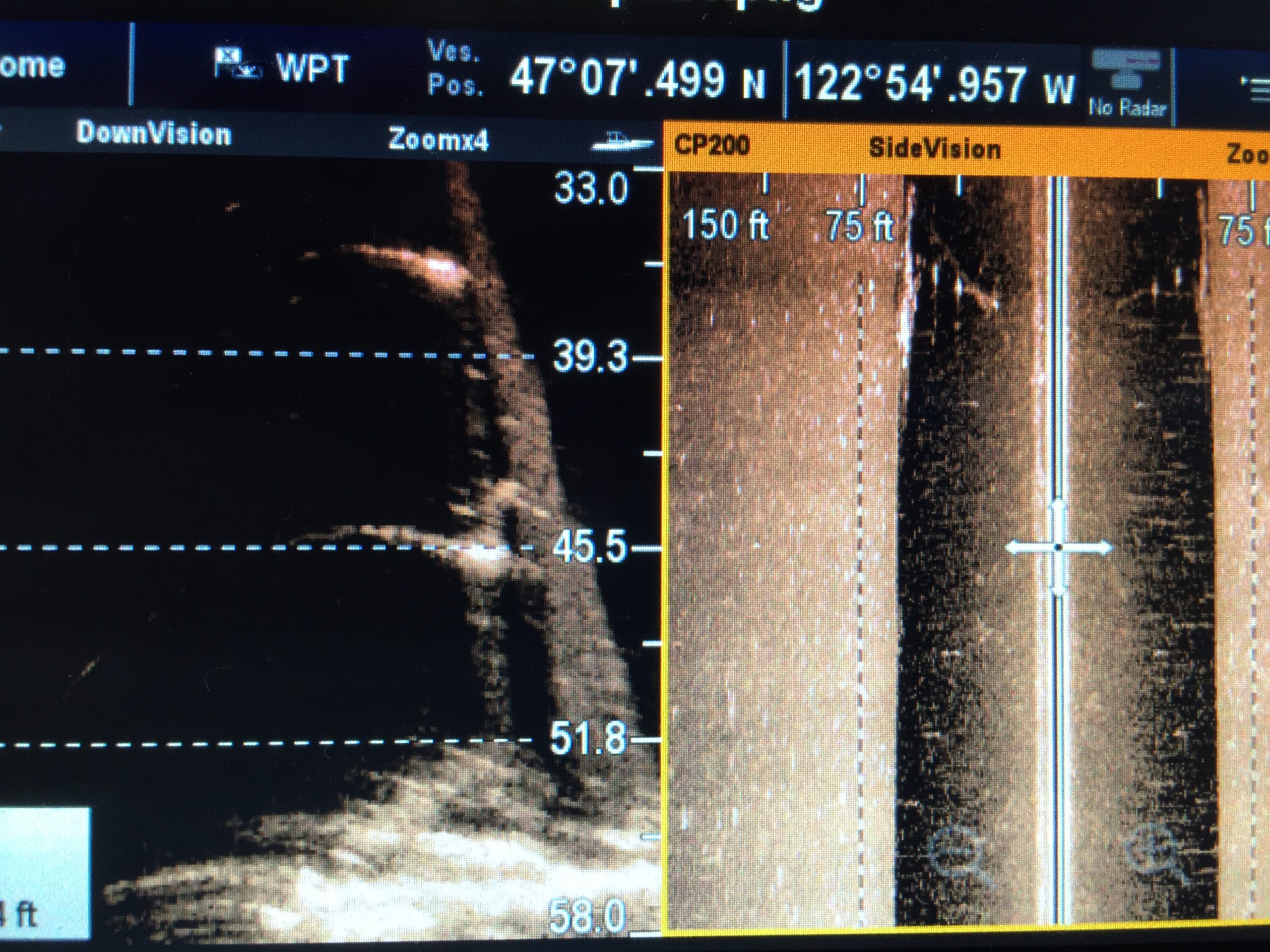
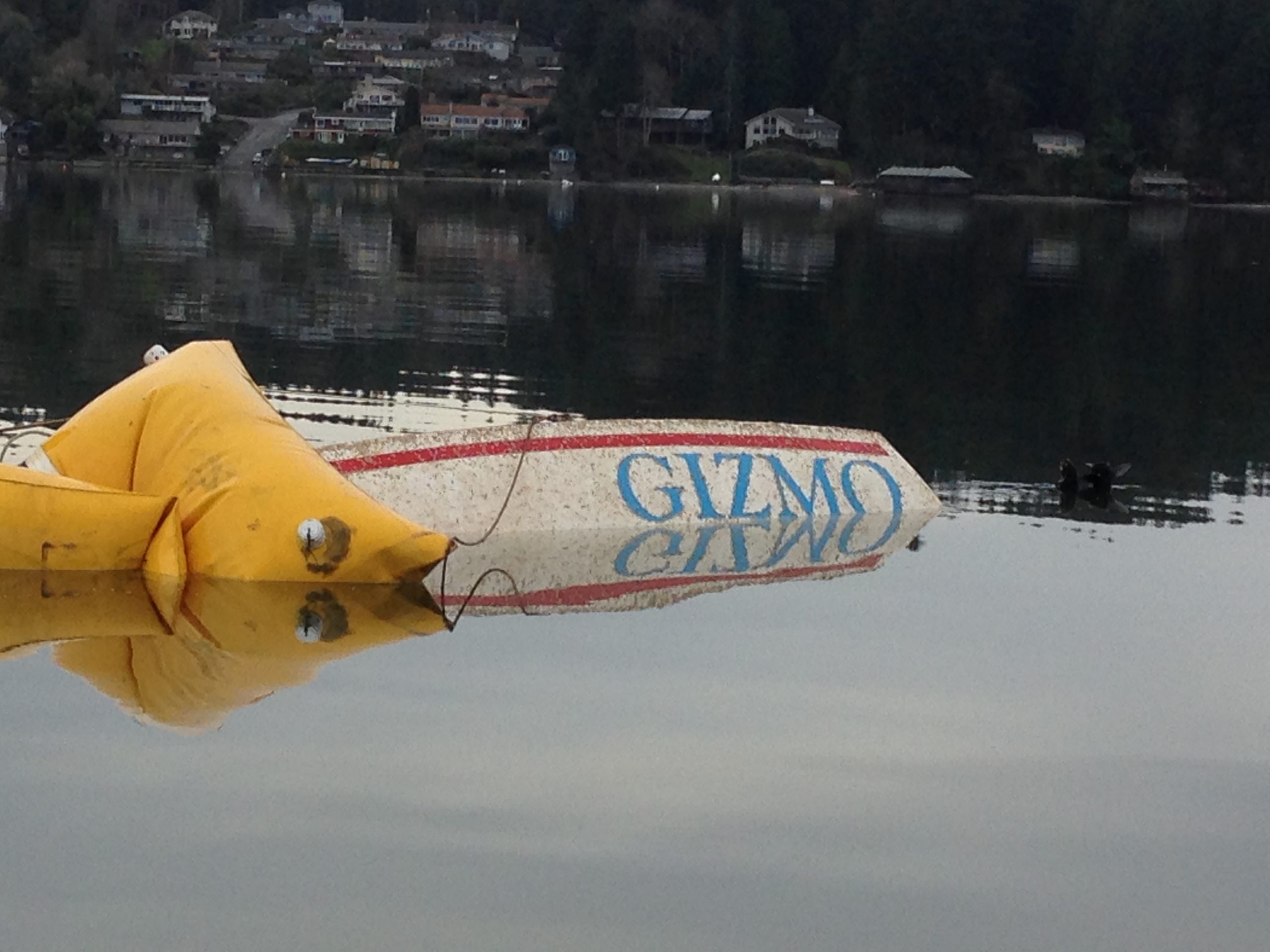
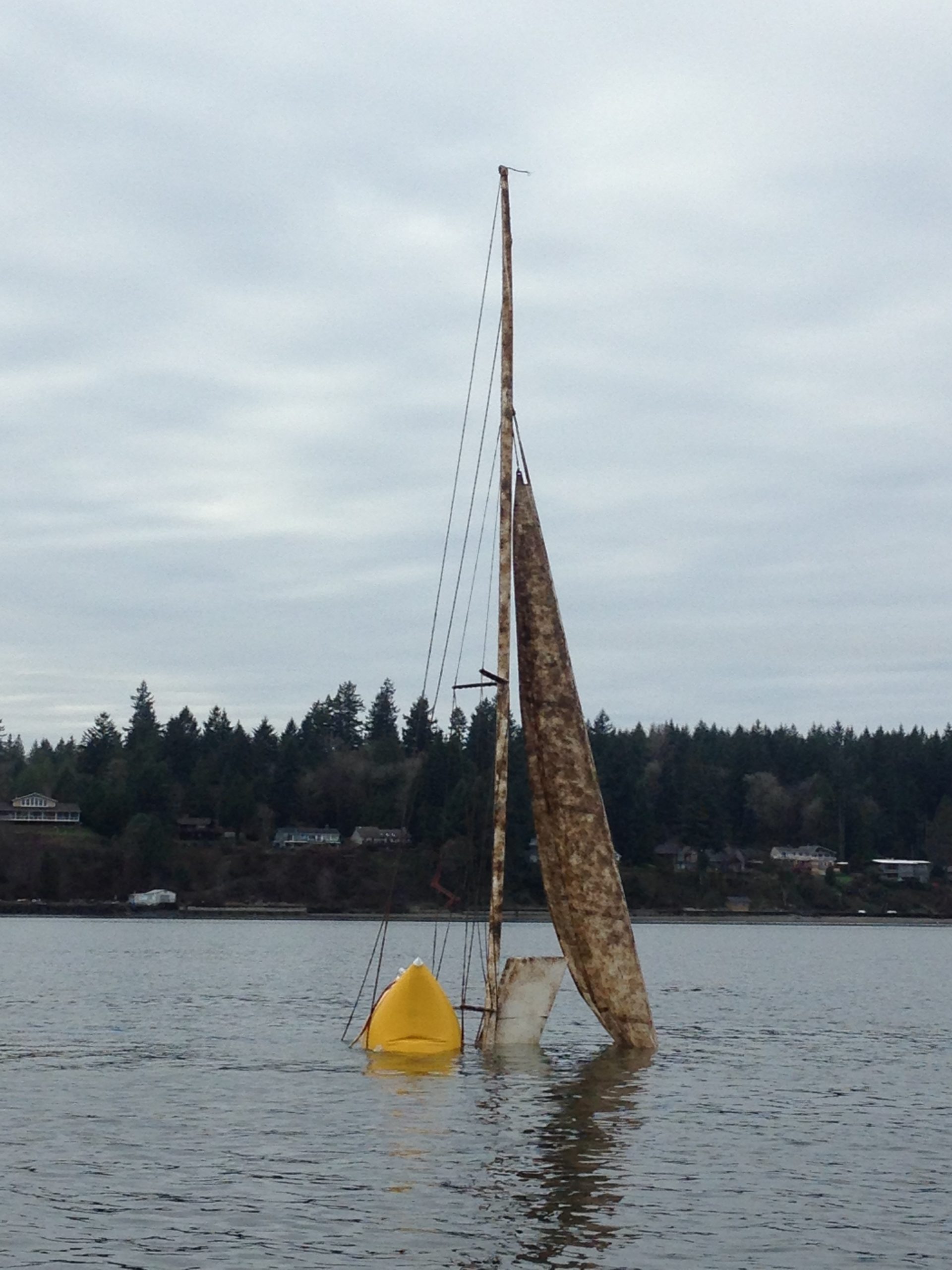
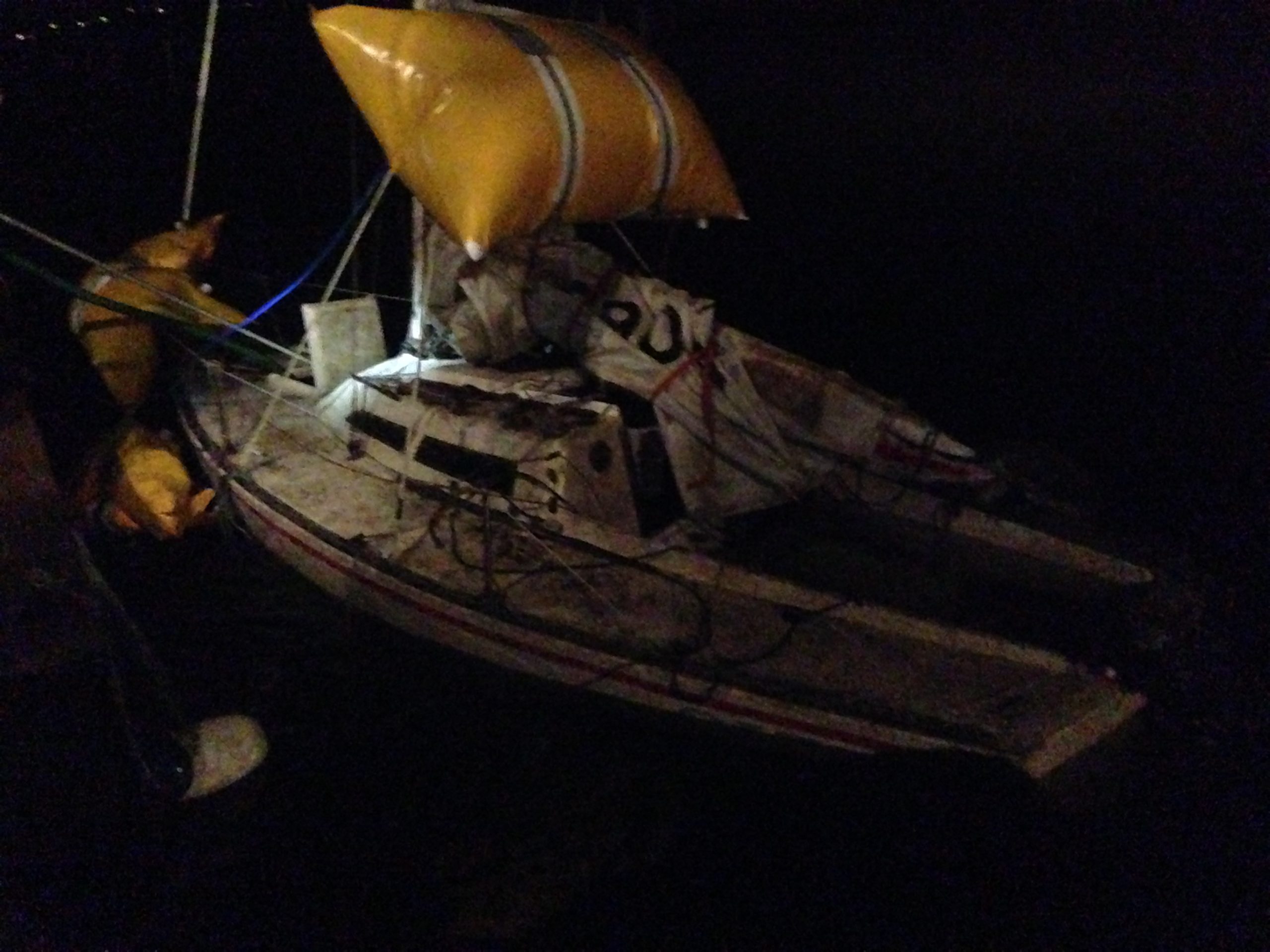


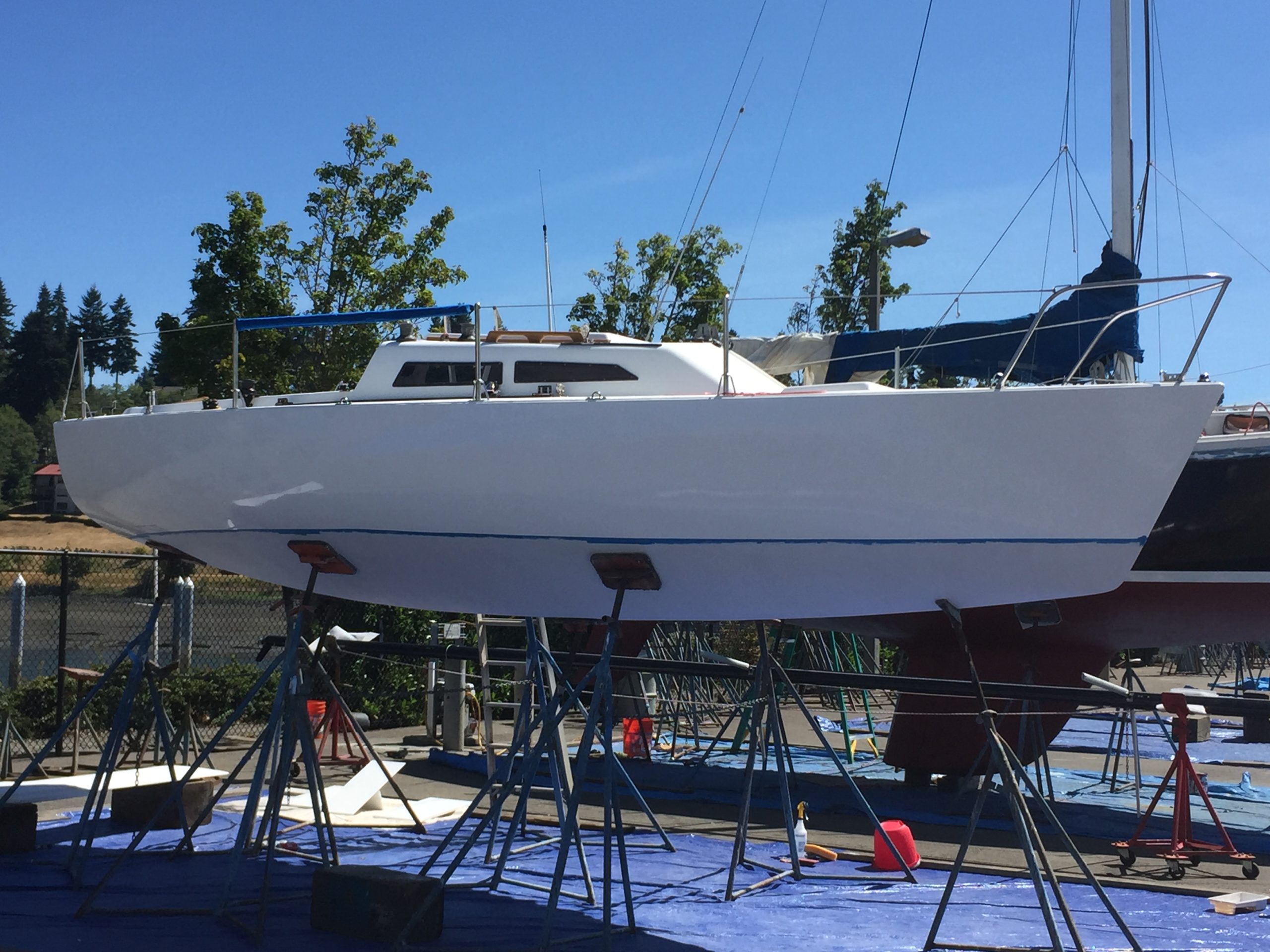
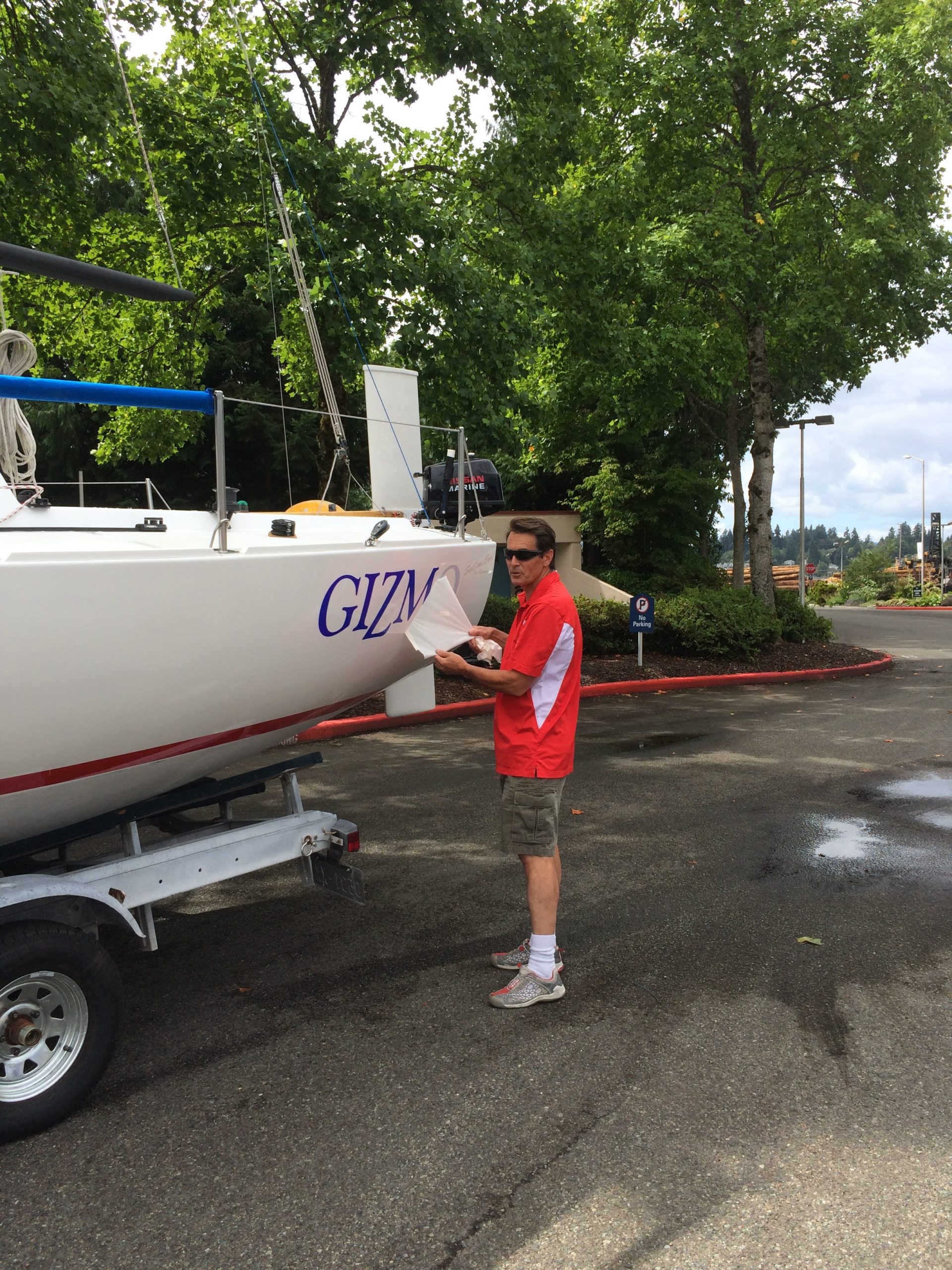
I only had liability insurance on the boat, so I was in doubt as to how I was going to afford to raise her. Maybe I could find her with a grappling hook, then rent a tank to tie some airbags on and tow her over to shallow water at high tide. I used to be a diver some 35 years ago….. Anyway, I filed an insurance claim and asked the adjuster about the recovery costs. I was told that all those costs were my own unless I was required to raise her by the Coast Guard. Either way, the insurance company needed a release from the Coast Guard stating that she could remain where she was. So, my next call was to the Coast Guard. After telling them where I thought she was, they promptly wrote me a letter stating that I was required to locate her, notify the Coast Guard of her position, and if she was in the shipping channel (which she was) I was to install and maintain a permanent lighted wreck buoy over her. That sounds an awful lot like a liability to me, and the insurance company agreed. So the recovery was on!
I had almost pulled the trigger on a new life sling for Gizmo the week before the Eagle Island Race, but opted for the DSC radio instead which came in the day before the race (I left it home, by the way, so I still have it). Had I bought the lifesling, it would have served me well on two accounts. First, it would have been another floaty thing (that’s a technical word for flotsam) in the water, and when you are in the water without a life jacket on, you can’t have too many floaty things around you. But, just as importantly, it has 175’ of line attached to the boat and would have marked her position nicely. I could have sent someone out the next day to pick her up. Just another shoulda-woulda-coulda!
Eric Egge, Susan Willis and I spent a day towing a grappling hook from Fjord while the rest of the fleet was out racing the Heron Island Race. We could only make about ¾ of a knot, so we didn’t cover much ground over 4-5 hours. After that, Susan came up with the idea of towing multiple hooks at once, so I went to work on that idea. Using a 20’ spreader bar, I rigged up 5 grappling hooks (actually one and four folding anchors off of the Star fleet’s buoys). It proved to be very ungainly and difficult to assemble in the back of Bill’s little runabout, but it finally worked. And it turned out that we did in fact snag Gizmo! But all that I succeeded in doing was ripping the mast crane off the mast. The lesson learned was that you don’t tie off the tow line to a cleat! But with 5 grappling hooks, that’s a lot of strain to hold in your hand. I had rigged a buoy to keep the hooks off the ground and dive planes on the spreader bars to keep the grappling hooks down as deep as possible. If it worked as I designed it, the hooks should have been suspended about 35-40 deep. Anyway, after snagging Gizmo once, we couldn’t repeat the snag a second time on subsequent passes so we moved on thinking that maybe the rig had just caught on the ground. A third day with the grappling hooks brought a more refined rig with three grappling hooks. By this time we had perfected to process enough so that I could motor along at about 3-4 knots and the hooks would stay down where they belonged. Any faster than that and the water would push them up to the surface despite the dive planes. But we covered all of the likely areas where she could possible lay.
Eventually giving up with the grappling hooks, I hired Osborne Marine to find her and raise her. They went out with a fish-finder which they claim was perfectly adequate to find mooring buoy weights. The difference is that when they are searching for mooring buoy weights, they know exactly where they are before they start. So there’s not much of a search. So they went out searching for Gizmo for a day or two, whenever the weather would permit. It was really rough in early November and we had to cancel the search on numerous occasions. In the mean-time, Jack Duray hooked me up with one of his friends, Greg Kluh who had a boat with a nice sonar system installed, so we went out for about 3 hours searching with the sonar. We did find something, though it turns out that it was just a large pile of debris that likely got pushed off a barge. Mark Osborne made two dives for me on objects that weren’t Gizmo. While we didn’t have any success that day, I had seen enough with the sonar to determine that if we were going to find Gizmo, it was going to take a sonar system to do it. So, I dug down deep into my pockets and bought a good quality Raymarine side scan sonar system thinking that I would sell it later to get some of my money back.
The weather still wasn’t cooperating. While December was calmer that November, the fog made it virtually impossible to steer a straight track line. The winds had to be calm because we had rigged the transducers to the back of a little boat that Mark had hijacked and lashed to the side of his tugboat, and any waves would bounce the little boat around and introduce noise into the display. The problem is that when there wasn’t any wind, then there would be fog making it impossible to stay on track. As December wore on, Mark went out whenever he could find a weather window and continued the search, eventually painting the GPS screen red with his track lines. By the end of December, it was starting to look like everyone else was right, that Gizmo had washed out into Dana Pass where she was beyond recovery. We had covered the entire northern Budd Inlet, and found nothing. Lots of bait balls and predator fish, but no Gizmo. So, on December 14, I called off the search thinking that I had enough evidence to petition the Coast Guard to let me leave her on the bottom of Dana Pass (deep!) which is where she must be since she’s obviously not in Budd Inlet. I went out to pick up the sonar equipment and take a snap shot of the GPS screen, and Mark showed me some images that he had saved as he searched. Most were more than likely just bait balls, but there was one that looked a little more solid and had a faint shadow behind it. I plotted the position and it was exactly where I thought Gizmo had gone down. We had searched that spot many times, and Mark had even gone back over the spot after seeing this image show up. So, without getting my hopes up, I let him try one more time. Just go back to that one spot and see if he could find anything, then we’d call it quits. The next day, I got a text saying “Found her!” The sonar images were amazing. There was no doubt at all that the image was Gizmo. You could clearly see the double spreader rig with the jib still up. Mark went down on Wednesday the 16th to mark her position and tie off a down line to her rail. We made plans to raise her on Friday the 18th. The weather was very marginal, but the presence of orcas ended any thought of diving. To a diver, they are killer whales, not orcas! Divers must look a lot like a sick seal to an orca.
So, Gizmo was finally raised on December 22. Mark made a four point bridle and fastened it to the toe rail and attached a single air bag to that. She popped right up to the surface with no hesitation. I was afraid that the daggerboard would be gone since there is nothing holding it in and she had turtled completely. Without it, the boat would not be much use. But, there it was, tangled in the rigging at the upper spreaders! Hallelujah! After four hours of struggling with her to get her up to the surface enough to pump out, Mark finally went and fetched his scow with a crane on it. He was able to attach that to the bridle and lift her to the surface, where she could eventually be pumped out.
Gizmo was intact, though she looked horrible. All the sails were there, the motor was there, the dagger board was there, even my margarita and beer were still on board. The beer had a funny smell to it so I tossed it, but I certainly enjoyed the margarita! My Go-Pro camera was still there and still worked! The boat was completely covered in barnacles after two months in the water. I sent the motor off to Tom’s Outboards and they were able to get it working again! The lifejackets and seat cushions were ruined because they had been compressed under two atmospheres of pressure and not recovered. Fortunately, I had left the upholstery and my new autopilot at home. The good sails all went up to North sails to be professionally cleaned. The old ones just got a rinse down in my driveway and hung up to dry. The boat has very little woodwork inside, but almost all of it came out unscathed. Mahogany and teak aren’t bothered by a couple of months under water. The marine grade plywood bulkheads look fine also. There was some cheaper plywood such as my steps that will need to be replaced, but for the most part all the woodwork was fine. I blasted the barnacles off with a pressure washer, then had to go over the hull with hydrochloric acid to dissolve all the little discs that they leave behind. The biggest issue with being under water, even for only two months, is the electrolysis of aluminum. Anywhere there was aluminum and stainless steel together, the aluminum was shot. The backing plates for the cleats and stanchions were gone. The most significant damage was to the mast itself. The stainless hardware was just fine, but the aluminum mast was eaten up severely at all the mounting holes. After seeing the jagged edges along the sail groove, I deemed it unusable. In for a penny, in for a pound, so I pulled the trigger on a new mast. I was actually able to get a brand new custom carbon fiber mast from Forte Composites for less than an aluminum mast! And they guaranteed that it would never corrode the next time I sank her!
Jay and I had been planning on stripping her down completely this past summer and restoring her, so I went ahead with it. With all new North 3DL sails (delivered a week after the sinking) and a new carbon mast, the hull really needed to be upgraded to match. Somehow, with encouragement from Eric Egge and my son and screams of “Stop! Stop!” from Susan, I managed to squeeze Gizmo into my garage with an easy ¼ inch to spare. I had to let all the air out of the tires to do it. And the trailer tongue stuck out 5 feet. She got a new paint job inside and out.
Gizmo’s triumphant return to the race course in the Eagle Island Race, along with our plans to do the R2AK, make all the work well worth it and a great tribute to Jay.





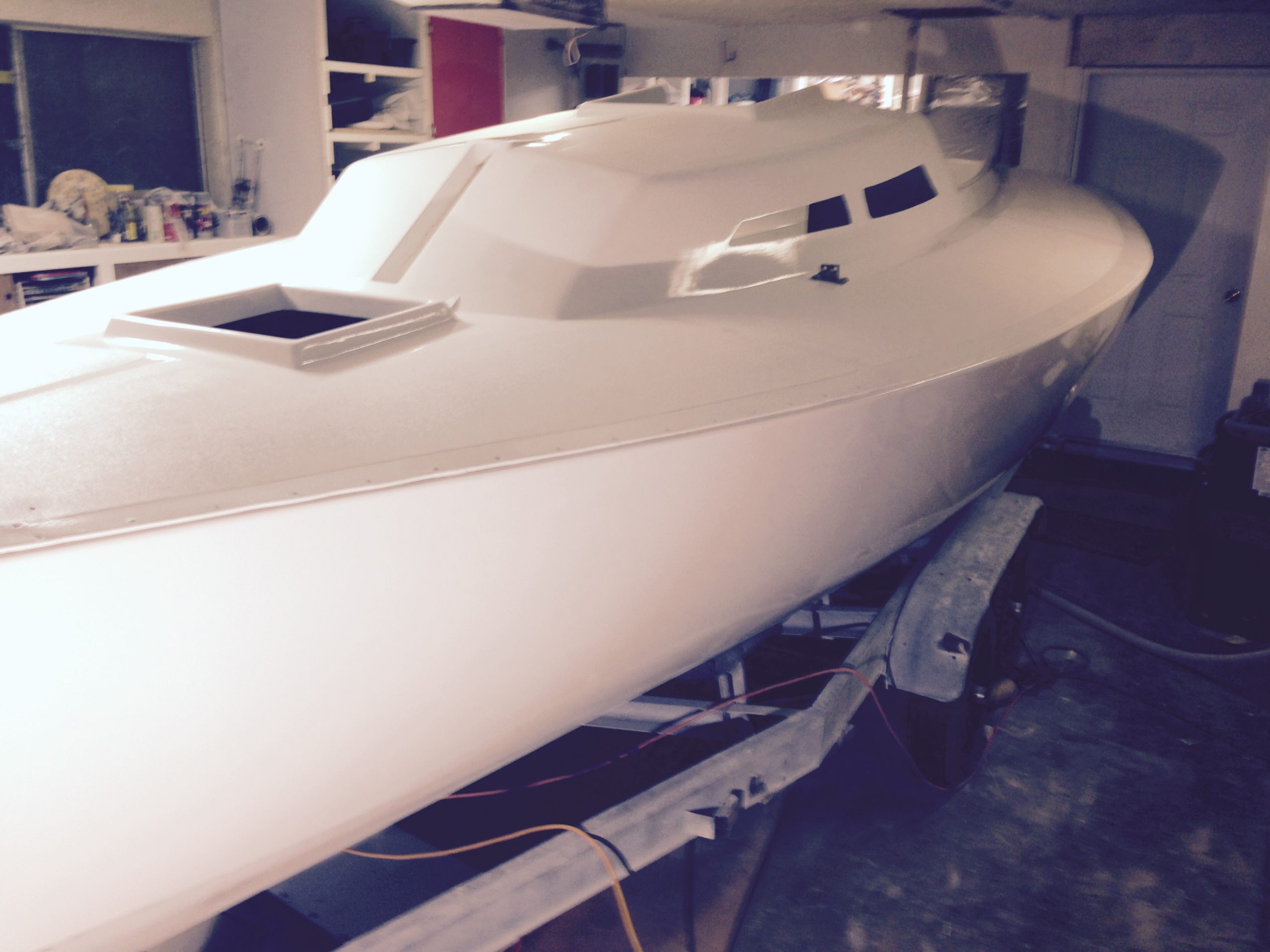
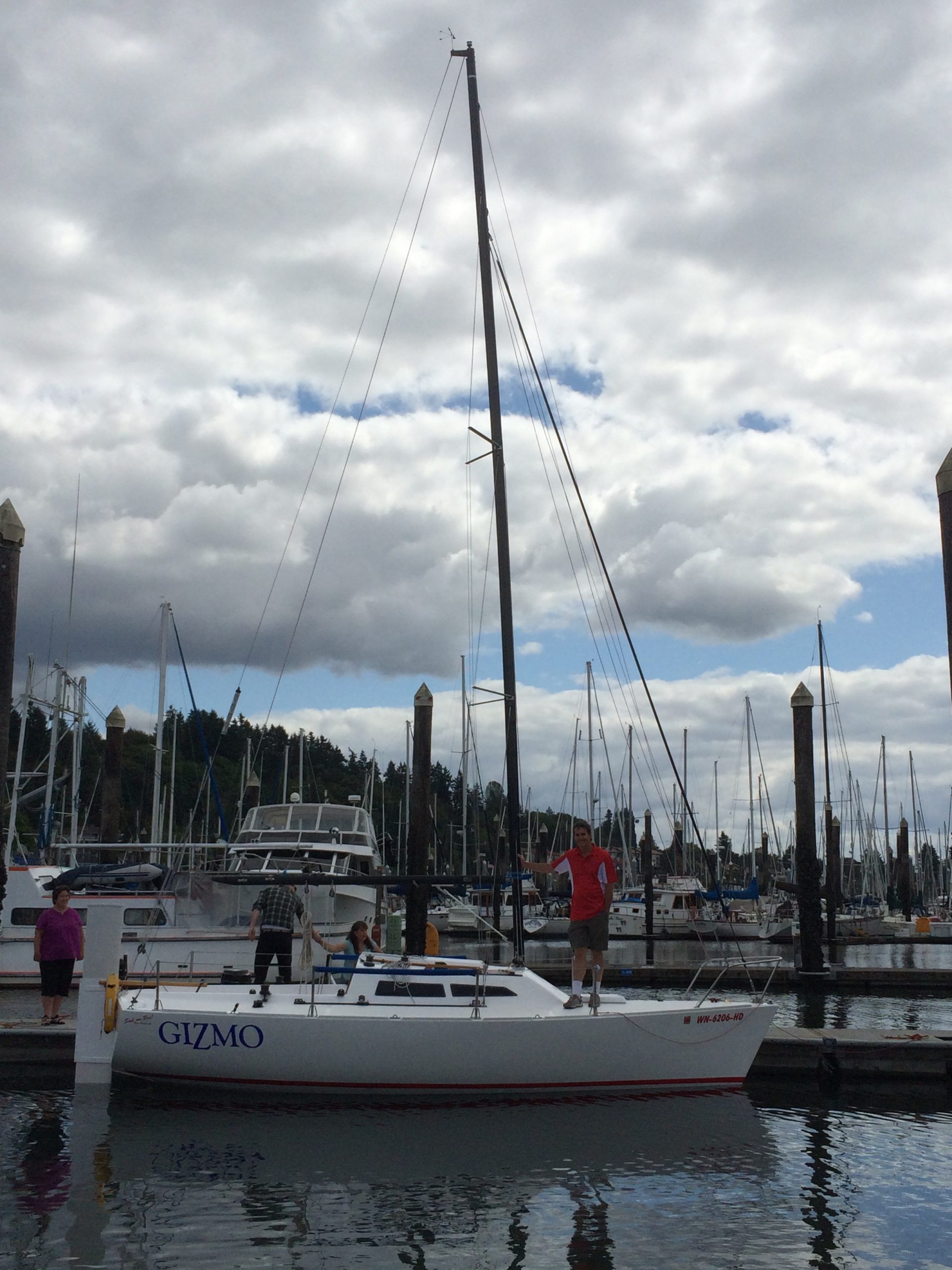
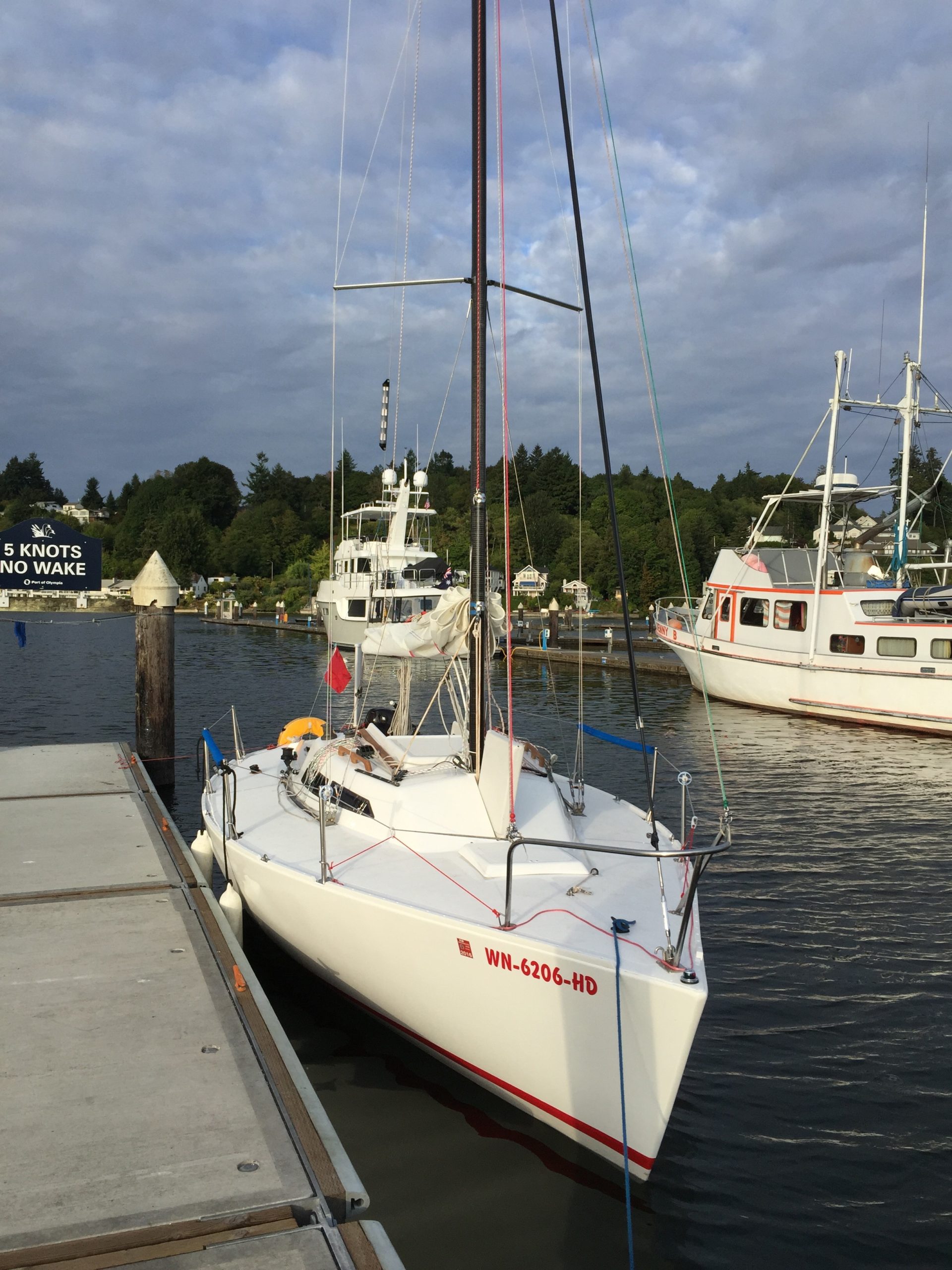
1 comment
Holy mother…what an experience. Thank you for writing it all down, I had been curious for years what had happened.